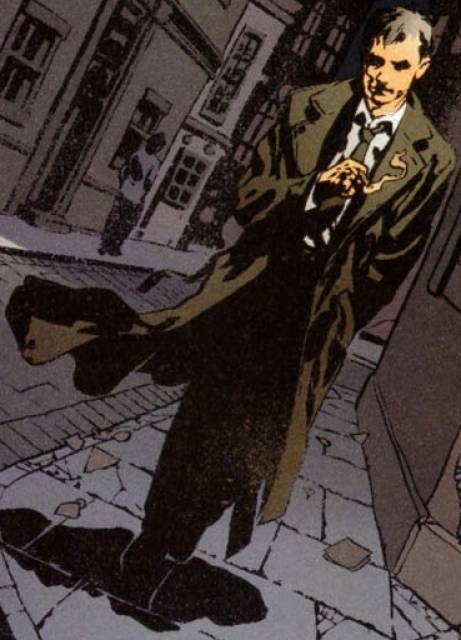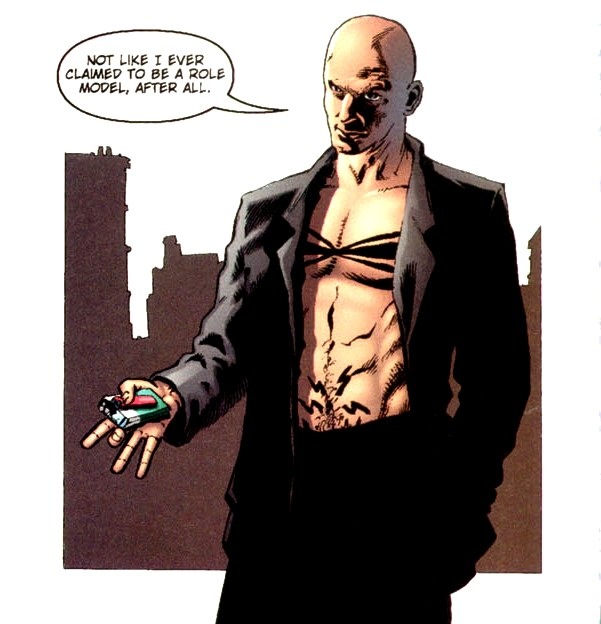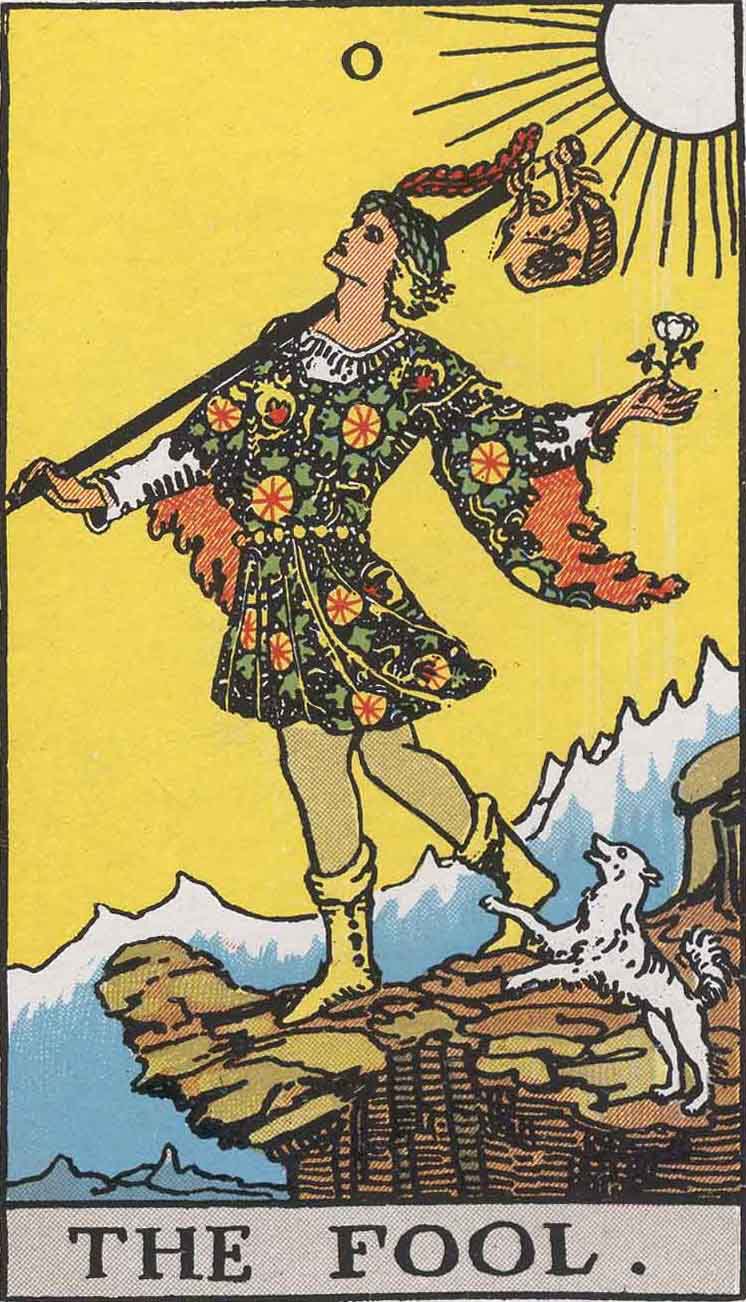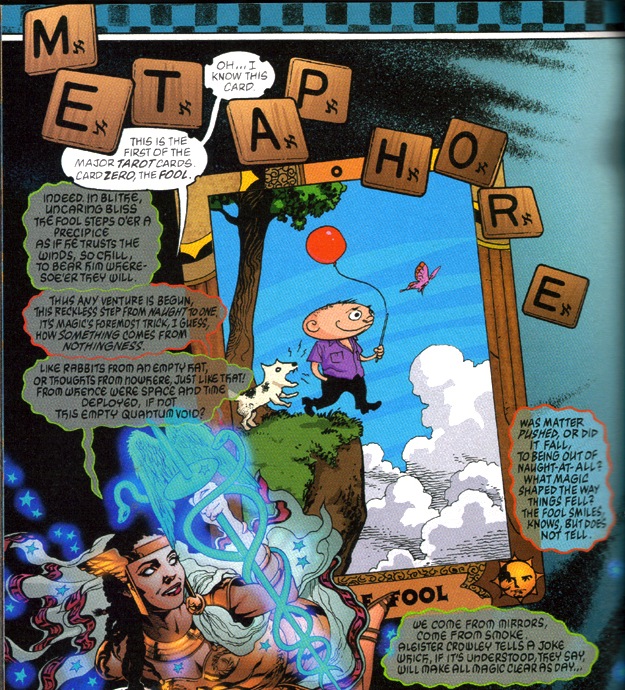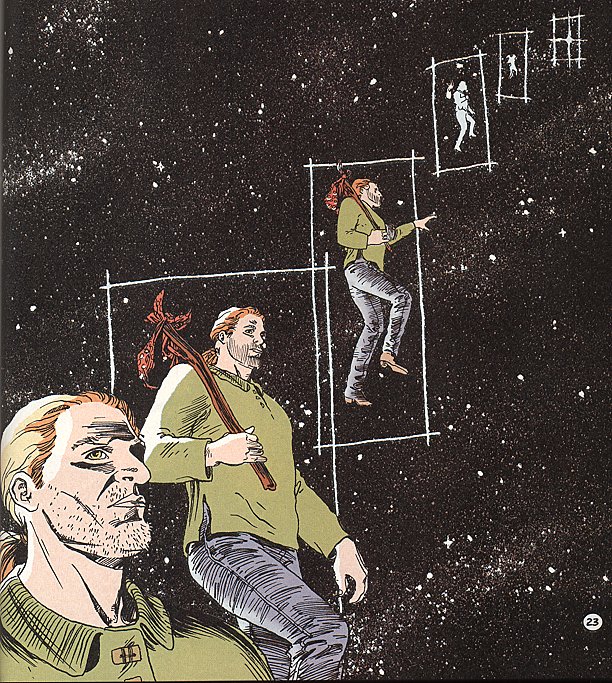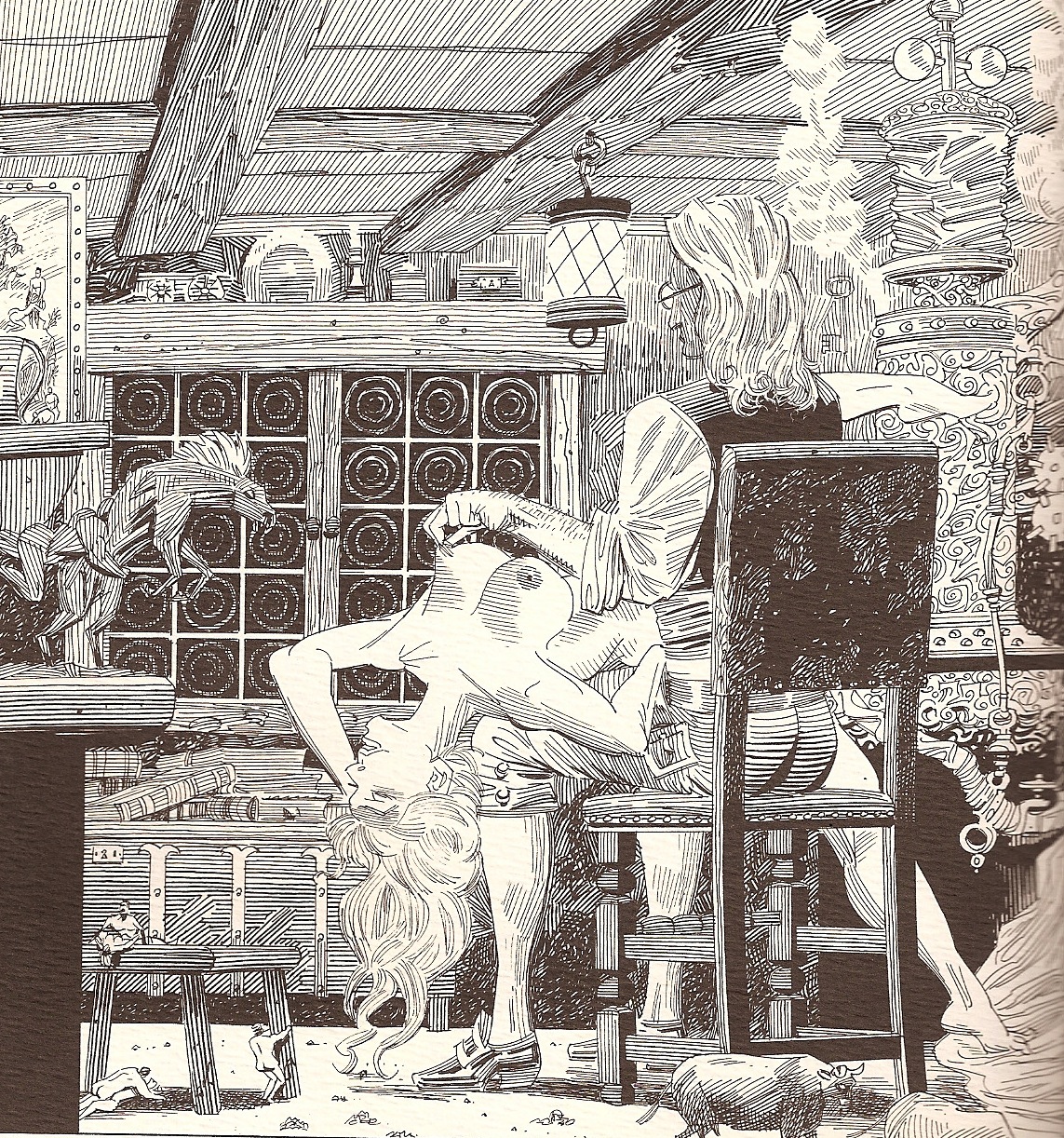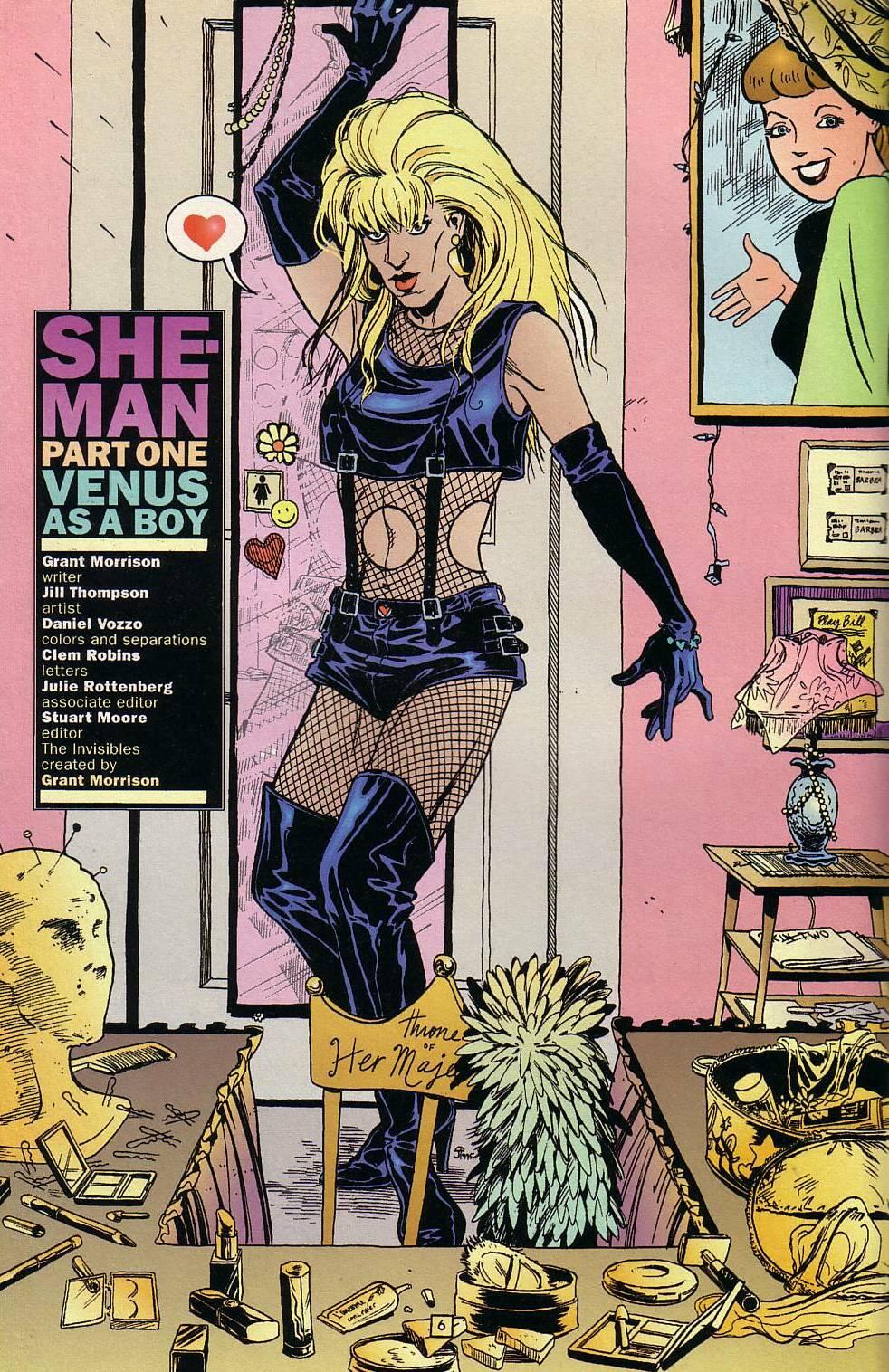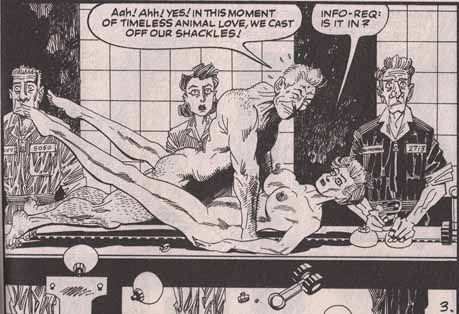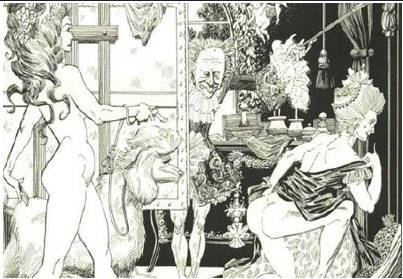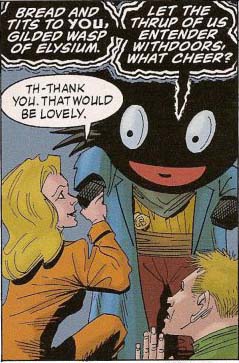Part One: Constantine
1969 ends with a surprise—the seventies.
In its last three pages, Alan Moore and Kevin O’Neill’s Century: 1969 suddenly departs from the eponymous year and drops us, without warning, a decade further on. The bright, LSD Technicolor has washed out of London, replaced with a heroin gray that never even fades to black, but only to darker and sootier grays. The place seems desolate, desperate, depressed, a throwback to the Ingsoc years, but without a Big Brother to blame. The Basement, a “Beat Club,” “where the Rutles first played London, apparently,” is now Debasement, a seedy punk bar where at closing time they probably don’t bother to sweep up the broken glass. The sixties, so hopeful at the peak, seemed to promise the world. The seventies promised nothing, and delivered. Nihilism is all the rage.
Another change as well: There’s an old man, who looks like a young man. Or is he a young man, who looks old beyond his years? He sits alone, slumped at a table, dejected. He has short, slightly spiky hair—more Richard Hell than Billy Idol—and he hasn’t shaved in a couple of days. He wears a suit that was probably pretty sharp when he put it on, but now looks like he slept in it—and, over that, a dingy trench coat. We know he is Allan Quartermain, but there at the end, I would swear he is John Constantine.
He may well be both.
We’ve seen this trick before. Warren Ellis and John Cassaday’s Planetary, chapter seven (“To be in England, in the Summertime”), begins by announcing the death of a Constantine stand-in named John Carter. “Who’s John Carter?” Elijah Snow asks.
“Old friend of ours,” Jakita says. “Had serious connections in the occult underground. Real player in the eighties.”
“The word,” the Drummer cuts in, “. . . is scumbag.”
We turn the page and we see him, in Jakita’s memory, slightly unkempt hair, cynical expression, trench coat. He is lighting a cigarette. By the end, we learn that Carter/Constantine is not really dead. He shows up, head shaved, the moon forming a halo behind him. When he takes off the trench coat, we see that he’s wearing a black sports jacket and no shirt underneath. Large, bold, black tattoos adorn his chest. Suddenly Jack Carter isn’t John Constantine anymore; he’s Spider Jerusalem instead.
“The eighties are long over,” he says. “Time to move on. Time to be someone else.”
He walks away, into the darkness, leaving behind the smallest drift of smoke, twisting like a question mark.
Both of these stories are, in their way, stories about stories. The League of Extraordinary Gentlemen began by assembling a Victorian superhero team—Quatermain, Wilhelmina Murray, Captain Nemo, Mr. Hyde, the Invisible Man—and filling their world with fictions borrowed from other fictions. Subsequent volumes in the series have followed the key characters as the years progressed and they grew old—or, in some cases, thanks to a Fountain of Youth, did not. Moore, then, does what he does best, simultaneously deploying adventure story tropes and commenting upon them.
Ellis does something similar in Planetary, where a team of “mystery archaeologists” tries to uncover “the secret history of the twentieth century,” and thus encounters alternate-world versions of superheroes, movie monsters, pulp adventurers, mad scientists, and other pop-culture figures. Here, too, the stories are critiqued even as they are told.
Moore borrowed Quatermain, but invented Constantine; Ellis borrowed Constantine, but invented Jerusalem. The transition—Quatermain, Constantine, Jerusalem—is interesting in several respects. For one thing, it is broadly in keeping with important aspects of each’s character’s story.
Allan Quartermain, whom Alan Moore once dismissed as “just another white imperialist out to exploit the natives” becomes, in the League‘s story, something more and something else. When we first find him he is a heroin addict, old and pathetic, strung out, filthy, and waiting to die. It takes a woman in danger to bring him back to his old self. And yet he doesn’t remain his old self. He grows tender, broadens, changes. He comes to respect Miss Murray as an equal, then to love her, then to love, also, the androgynous and immortal Orlando. He travels to a magic pool and comes back a young man, posing as his own son. He is no longer the “old” Quartermain at all. Alan Moore thus reinvents Allan Quatermain. And Allan Quatermain reinvents himself.
Constantine, as a kind of magical con artist, lives by his wits. He is constantly adapting, constantly improvising. The central conflict of Hellblazer is that of the individual, a mere human, confronting powers much greater than himself—heaven, hell, and Margaret Thatcher. The question the series poses, taken as a whole, is how much of a bastard can one be and remain a decent sort of guy? Or, at times: How much of a bastard does one have to be? Of course, the temptation—for John and for his writers—is always to push it too far. The challenge for the writer is to stay true to the character; the challenge for John Constantine is to stay true to himself.
Transmetropolitan poses many of the same questions, the same challenges. Spider Jerusalem is a rogue journalist, a cyberpunk Hunter S. Thompson, determined to tell the truth and consequences be damned. The story he’s pursuing, or a crucial part of it, concerns the persecution of the “Transient” community, a rather cultish group who alters their genetics to become part alien. In other words, Transmetropolitan is about the relationship between integrity and autonomy, and in particular the defense of the second being required for the preservation of the first.
A theme uniting the two transitions—Quartermain to Constantine, Constantine to Jerusalem—is the idea that heroic characters are expressions of the cultural needs of their eras. Thus Jakita’s explanation for the “faintly ridiculous” appearance of the Vertigo heroes: “They’re eighties people.” And furthermore, they’re English: “England was a scary place. No wonder it produced a scary culture.” Thus, also, Alan Moore’s observation in his introduction to The Dark Knight Returns: “[H]eroes are starting to become rather a problem. They aren’t what they used to be. . . or rather they are, and therein lies the heart of the difficulty.” He goes on to explain: “The world about us has changed and is continually changing at an ever-accelerating pace. So have we.” However, despite advances in technical knowledge and social conscience, “comic books have largely had to plod along with the same old muscle-bound oafs spouting the same old muscle-bound platitudes while attempting to dismember each other.” Changing times, he says, demand “new themes, new insights, new dramatic situations.” Our heroes have to change.
The personal tension in 1969—between Mina, Allan, and Orlando—largely hinges on their different approaches to adapting to the new times. Mina is somewhat desperately trying to adopt the most up-to-date dress and slang, an affectation that her teammates find ridiculous. It’s easier for Allan, at least on the surface, as men’s fashions are more stable (witness the iconic trench coat) and the culture is more forgiving to men as they age—not that he ages, exactly. But Mina, perhaps because of her earlier, less idyllic experiences with immortals, has picked up on something deeper. She fears obsolescence, becoming “fossilised as a Victorian freak” in a world that will grow increasingly alien. For Orlando it is different. Orlando is always changing—names, sexes, allegiances; even her history is subject to revision—and Orlando is never changing. He, or she, is a constant throughout history, always present where the drama unfolds, cynical and self-centered past the point of narcissism. Whatever tragedy he may witness, we can be sure that he will be counted among the survivors. Fashions change, ideas changes, and Orlando will take them up, or not, as it suits her. His very mercurial nature is a kind of constancy; whatever else happens, Orlando will adapt and survive. There is a stable center beneath the shifting appearances, the momentary attachments. And so, in the shadows and grime of the seventies, as they discuss Mina’s disappearance and the end of their League, it is naturally Orlando who gets up and leaves. Quatermain remains, unsure what else he could do.
Part Two: The Fool
In Books of Magic, Neil Gaiman and Paul Johnson present Constantine as an archetype drawn from the Tarot. Dressed as the Fool, he mocks, and riddles, and provokes.
The occultist Arthur Edward Waite wrote of the Fool:
“With light step, as if earth and its trammels had little power to restrain him, a young man in gorgeous vestments pauses at the brink of a precipice among the great heights of the world; he surveys the blue distance before him – its expanse of sky rather than the prospect below. . . . The edge which opens on the depth has no terror; it is as if angels were waiting to uphold him, if it came about that he leaped from the height. His countenance is full of intelligence and expectant dream. . . . He is the spirit in search of experience.”
Johannes Fiebig and Evelin Bürger add that the card’s number, Zero, “indicated a very personal bottom line, the self, the starting point from which everything else flows. This is the beginning and the end of that which makes you a unique person.” They advise: “You must have the courage to face the future, even if you cannot predict or determine the future in advance. You must have the courage to walk your own path and to be open, even if your back isn’t covered, and even if conventional wisdom and common sense suggest otherwise.”
In Promethea, Alan Moore, Constantine’s creator and a practicing magician himself, describes the Fool in verse:
“Indeed in blithe, uncaring bliss
The Fool steps o’er a precipice
As if he trusts the winds, so chill,
To bear him wheresoe’er they will.
Thus any venture is begun,
This reckless step from naught to one.
It’s magic’s foremost trick, I guess,
How something comes from nothingness.”
In some depictions, the Fool is accompanied by a bird (perhaps representing freedom) or a butterfly (transformation). Moore’s Promethea and Gaiman’s Books of Magic—stories of quests, in which a novice is introduced into the world of magic—both show the butterfly in their versions, or in the first case, a Promethea moth. Moore’s Fool seems to be following it over the edge.
Gaiman has made use of the Fool before. In the Sandman series, Destruction, who has long ago abdicated his responsibilities, decides he cannot stay in the home he has made for himself since abandoning his realm.
“What will you do now?” Dream asks.
“I will make the most of what I’ve got. I shall live out my days doing what I have to do, one day at a time. Life, like time, is a journey through darkness.”
A few pages later, Dream inquires again, “You are going now?”
“Yes.”
“Where?”
“Oh, out there, somewhere. Up, out.”
We see him, carrying a stick with a bundle knotted at the end, walking up into space, until he is as small and as bright as a star. It is the Fool, stepping over the edge at last, and rising rather than falling.
Destruction, like the Fool, has a dog for a companion. “Barnabas can be a bit of a pain,” Destruction says, “and he has no poetry in his soul, but he means well.” In the Tarot, the dog represents caution, prudence, and common sense; he sounds a warning as the Fool approaches the cliff. It is fitting that Destruction, or the man who was once Destruction, when he steps into the sky, leaves the dog behind, on firm ground.
The theme of transformation—”time to be someone else”—is in fact the moral of Neil Gaiman’s Sandman series: “One must change or die.” Destruction decides to change; Morpheus, to die.
Constantine’s greatest trick was probably surviving for as long as he did. He is after all, just a working-class bloke with a habit of getting in over his head. If he could be said to have powers at all, they would consist chiefly of arrogance, recklessness, a certain rakish charm, and a large measure of pure blind luck, along with knowing a little of magic and a lot of people. It is, in fact, precisely the same qualities that get him into trouble and get him out of it.
As William Blake wrote in his “Proverbs of Hell”:
“A fool who would persist in his folly becomes wise.
Folly is the cloak of knavery.”
The Fool is a knave by another name. “Not John,” Constantine’s end-of-everything doppelganger tells Tim Hunter, “But Jack . . . Jack Fool. . . . A Jack-a-Napes when I tell riddles and merry tales; Jack Pudding, when I play my pranks. . . .” And the jack in a deck of cards is sometimes also called the knave.
This knave, cloaked in folly, knows more than he says. Moore writes:
“What magic shaped the way things fell?
The Fool smiles, knows, but does not tell.”
When young Tim Hunter asks the Constantine-Fool, “I’m meant to be learning about magic. What have you got to tell me?” The reply is a feint of ignorance: “Me, good sir? What do I know of magic? Why, nothing, my masters. Nothing at all.” But as he speaks, as he tells them he has nothing to say, he is at the same moment creating and then juggling balls of white flame—literally playing with fire. Is he brazenly lying, or is he hinting at a deeper truth—that there is daring but no wisdom, that magic is a question of will rather than knowledge? Is it skill or is it luck? Constantine’s brand of magical bluffing suggests that the two often amount to much the same thing. The only trick is not losing your nerve until you see it through to the end, whatever that may be.
Part Three: Promethea
In Snakes and Ladders, Alan Moore tells of seeing John Constantine in a sandwich shop: “He looks at me. He nods, and smiles, and walks away.” (He smiles, knows, and does not tell.)
“Years later,” Moore continues,”in another place, he steps out from the dark and speaks to me. He whispers: ‘I’ll tell you the ultimate secret of magic.'” We see him, cigarette in hand, and a slight, mischievous smile. Moore leans toward him, listening.
“‘Any cunt could do it’,” Constantine says.
The casual manner is a pose. Constantine promises to tell us a secret—or more, the secret—then seems not to, but actually does. It’s not just showmanship, it’s illustrative. It is itself a part of the secret—the smiling, knowing, telling, not telling. (“What do I know of magic? Why, nothing…. Nothing at all.“) It’s a coded language, a teasing performance full of double meanings. The profanity is part of it as well. “[The] profane and scared are both one,” Moore writes. Cunt, you understand: Is it literal or metaphorical? And what is the difference?
Moore’s Promethea is another story of an artist conjuring a fictional character into reality. A young student, Sophie Bangs, is researching a mythical figure who recurs in stories throughout the history of literature. What she discovers is that
“Promethea was a real little girl who lived in 5th century Roman Egypt. Her father was a hermetic scholar. . . sort of like a magician. A Christian mob killed him. . . But the gods intervened, taking his daughter into their world of myth and fiction, The Immateria. Promethea became a living story, growing up in the realm that all dreams and stories come from. Sometimes, she’d wander into the imagination of mortals. . . . Some of them, taken over by this powerful living idea, even physically became Promethea. . . . See, anyone with imagination and enough enthusiasm for the character can bring her through from the Immateria, by thinking themselves or others into the role.”
Sophie becomes the latest incarnation of Promethea, leading her—and therefore, also, the reader—on a instructive quest to learn about magic, or at least the basics of Alan Moore’s theory of it. Some of what she learns helps to elucidate the meaning of Constantine’s secret.
The magician Jack Faust instructs her: “The vessel between woman’s thighs is the cup’s highest aspect. The chalice. The grail of divine compassion.” Later, they have sex, and he continues:
“Magicians, irrespective of their gender, are male. Their symbol is the wand, the male member, because they are that which seeks to penetrate the mystery. But once they succeed—then they become magic. They become the mystery, become that which is penetrated. They become female.”
This is all rather literal in the story. Writers and artists, their pens and pencils serving as their wands, approach a woman who is not only mythic but myth itself, who is imaginary and who represents imagination. Those who are most successful, at least one man included, then actually become her.
Later, Sophie encounters a female Aleister Crowley, who reiterates Faust’s point: “Here, magicians become magic itself. The penetrator becomes the penetrated. Male becomes female.”
Sex is magic, magic is creation. Magic is about transformation, change. But it is also about unity, and the unity of opposites in particular—illusion and reality, male and female, virgin and whore, sacred and profane. Something doesn’t just come from nothing: the emptiness contains everything within it already. Zero means nothing, but it is also the number of infinite potential. Transformation is also a revelation, and the revelation transforms. Magic is a system, a system of meanings, perhaps of essences—but it is an unstable system, a destabilizing system. That is why it is transgressive. That is why it is dangerous.
And in a sense it is dangerous whether it exists or not. Magic may not be real in the way that toothbrushes and parking meters are. But stories are real; symbols are real. They may only exist in the mind, or in the culture, but they have real effects. Tampering with the symbols, Moore argues repeatedly, changes consciousness, changes the meaning of things. If this idea is even remotely correct—and for these purposes it makes no difference whether we conceive of the process as “magic,” as Moore does, or simply as “art”—then the project of re-imagining our heroes takes on new importance, and greater urgency. It’s not just about having better comics, but about finding new ways of seeing the world, and new ways of being in it. Changing ideas changes the world. It’s just a matter of imagination, and having the nerve to take the first step.
When Sophie next encounters Crowley he is dressed as the Fool, sitting at the bottom of an ornate staircase reaching to the heavens. At the top, he tells her, one can “behold the vision of God, face to face.” Crowley, the gloomy Fool, waits uncertainly, despondently. “I’ve always been sitting undecidedly here,” he says. But also, he says, “I’ve always been there,” up above. “You go ahead,” he tells Sophie. “Good luck with God.”
God turns out to be the moment of creation: “Something from nothing. One from none. . . . Always here. Always now. . . . One perfect moment, when everything happens.” Implicit in that moment is the unity of all Being. “All one. All God. . . . We are each other. And we are God. . . . And God is one. And one is next to nothing.” There, in that bliss of oneness and that barely-there heaven, along with everything else, is (again) the Fool—the familiar image this time, the one taken from the Tarot. Satchel over his shoulder, dog barking behind him, his next step will take him over the ledge. Perhaps there is some slight resemblance to Crowley.
And from that ultimate height, one finds another edge. Looking down one sees the universe, arrayed like the Kabbalah. Sophie steps over, and falls back into our world.

